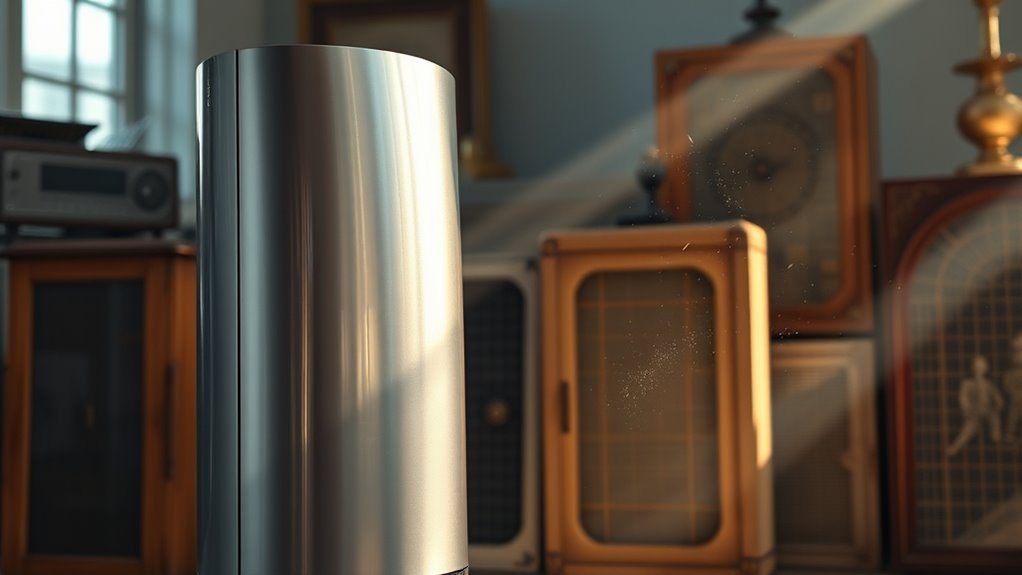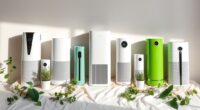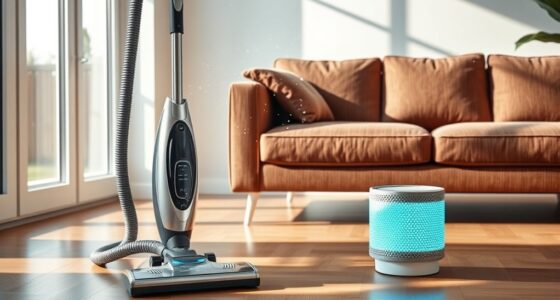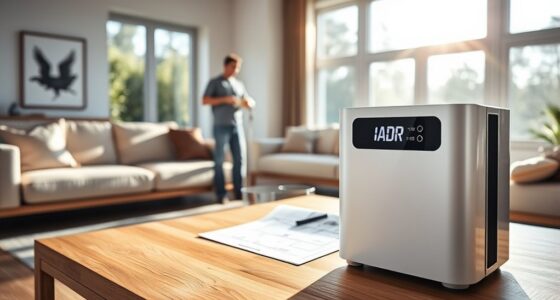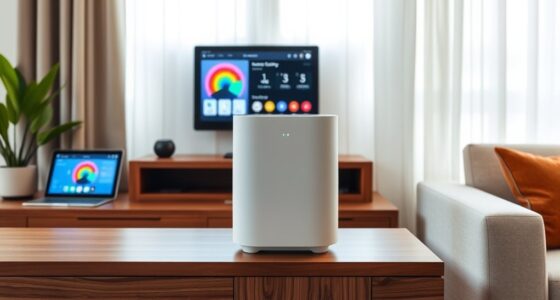Air purification technology has come a long way, starting from ancient Egyptians using charcoal for cleaner air to modern HEPA filters capturing 99.97% of harmful particles. The 1970s brought HEPA filters into homes, revolutionizing indoor air quality. Today, smart air purifiers feature advanced technologies like UV-C light and real-time monitoring. Sustainable practices are now at the forefront, ensuring eco-friendly solutions. As you explore further, you’ll uncover even more fascinating developments in this essential field.
Key Takeaways
- Ancient civilizations, such as Egyptians and Romans, laid the groundwork for air purification using materials like charcoal and engineered ventilation systems.
- The introduction of carbon filters in 1862 marked a shift from water to air filtration technologies, enhancing indoor air quality.
- HEPA filters were developed during World War II and became a household standard in the 1970s for capturing 99.97% of airborne particles.
- Innovations in filtration technology led to multi-stage systems and the integration of activated carbon and UV-C light for improved air purification.
- Sustainable practices and smart technology advancements are shaping the future of air purification, focusing on eco-friendly materials and real-time air quality monitoring.
Ancient Beginnings

Air purification has roots that stretch back to ancient civilizations, where people recognized the need for clean air to maintain health. The ancient Egyptians utilized charcoal as an effective air purification method, showing its importance across societal classes around 2500 BCE. This early use of activated charcoal filters laid the groundwork for modern air purification techniques. In addition, the effectiveness of activated carbon filters in absorbing harmful substances has been a vital aspect of air purification throughout history. Moreover, advanced cleaning features in contemporary air purifiers have evolved to further enhance indoor air quality.
Fast forward to the Romans, who engineered remarkable systems to improve indoor air quality, enhancing both air circulation and aesthetics.
The Romans revolutionized indoor air quality with innovative systems that enhanced both circulation and aesthetic appeal.
By the time of the Industrial Revolution, increasing coal usage intensified the need for cleaner air. In 1823, John and Charles Dean invented the smoke helmet, an early form of air filter aimed at protecting firefighters from toxic fumes.
Later, in 1854, John Stenhouse advanced filtration technology with a charcoal-based filter mask for coal miners, marking significant strides in personal respiratory protection. The ongoing evolution of air purification technology has led to modern devices like air purifiers that effectively remove allergens and pollutants from indoor environments.
The Birth of Carbon Filters
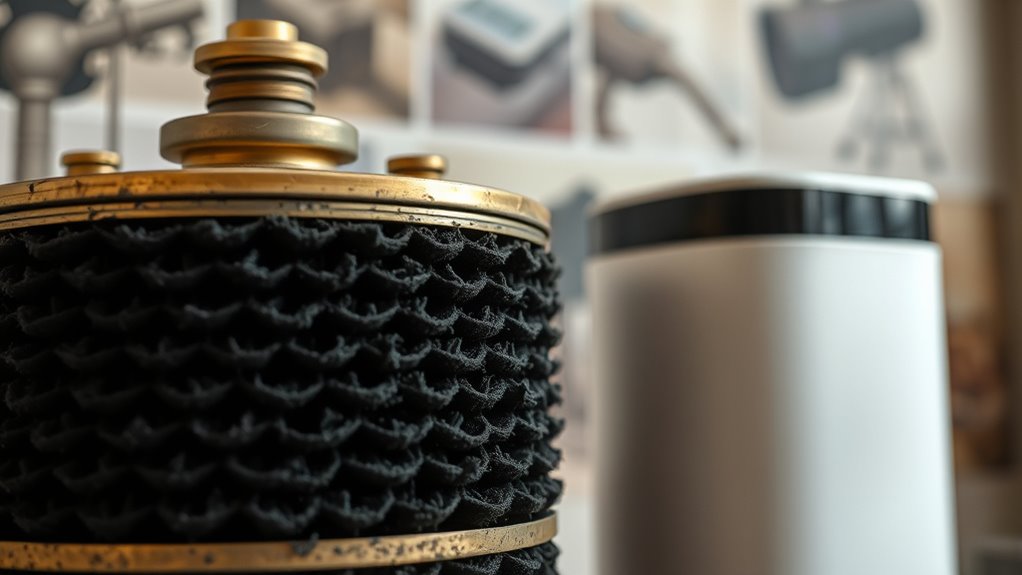
The Birth of Carbon Filters
In 1862, the concept of carbon filters emerged, initially aimed at water purification before shifting to air filtration. This marked a pivotal moment in filtration technology. By 1872, the Rice brothers introduced a two-stage filtration system, laying the groundwork for future advancements in activated carbon filters. Recognized for their effectiveness, these filters capture and neutralize airborne pollutants, markedly enhancing indoor air quality. Regular cleaning of air purifiers is essential to maintain their effectiveness, especially when using carbon filters. Additionally, the understanding of refrigeration cycles has contributed to innovations in air purification technology over time. As technology evolved, the introduction of energy-efficient models further enhanced the performance of air purification systems. Furthermore, the integration of multi-stage filtration systems has become a common feature in modern air purifiers, improving their overall effectiveness.
As the 20th century progressed, carbon filters gained prominence in air purification, particularly for their ability to adsorb volatile organic compounds and harmful gases. Today, carbon filters are integral to air cleaning systems, often working alongside HEPA filtration to provide thorough solutions for cleaner, healthier indoor environments. This evolution showcases the rich history of air purification technology.
The HEPA Filter Revolution

You might be surprised to learn that HEPA filters originated during World War II to trap radioactive particles, a secret weapon in air purification. Since then, advancements in filtration technology have made these filters essential for improving indoor air quality. As you explore their impact, you’ll see why HEPA filters have become a household name in air purifiers today. Additionally, energy-efficient models equipped with HEPA filters can significantly reduce electricity costs while enhancing air quality. Regular use of air purifiers with HEPA filters can lead to improved respiratory health and alleviate symptoms of asthma and allergies. Many modern air purifiers now incorporate additional technologies, such as activated carbon filters and UV-C light, to further enhance their effectiveness in reducing indoor pollutants. These advancements ensure that air purifiers remain at the forefront of air quality improvement technology, continuously adapting to meet the needs of consumers. Furthermore, the integration of smart home devices into air purification systems has further increased their usability and effectiveness in maintaining clean air.
HEPA Filter Origins
The revolutionary HEPA filter, short for “high efficiency particulate air,” emerged during World War II as a critical tool for the US Army Corps to capture radioactive particles.
Initially deemed top-secret, HEPA filters were designed to remove at least 99.97% of airborne particles sized 0.3 microns, effectively tackling a range of pollutants like dust, pollen, and smoke. The rise of sustainable fashion has also influenced the demand for cleaner indoor air environments, as consumers increasingly prioritize health and eco-friendliness in their living spaces. Regular tick checks provide economic benefits through job creation in manufacturing, installation, and maintenance sectors. Additionally, professional counseling can enhance understanding of the importance of clean air for overall well-being.
In the 1960s, the U.S. Department of Energy standardized the term “HEPA,” establishing specifications that air filter manufacturers had to meet.
While HEPA filters began in specialized facilities due to their bulkiness and cost, advancements in air filtration technology led to their commercialization in household purifiers during the 1970s and 1980s, spurred by growing concerns about indoor air quality. Additionally, the proper maintenance of air purifiers is essential to ensure optimal performance and longevity of HEPA filters.
Advancements in Filtration
As air quality concerns grew, advancements in HEPA filter technology transformed them from bulky, specialized equipment into essential tools for everyday households.
Initially developed during World War II, HEPA filters now boast the ability to capture at least 99.97% of particulate matter sized 0.3 microns. Energy efficiency evaluations can also help homeowners understand the overall air quality in their living environment.
Thanks to advancements in technology, these filters became smaller and more affordable, making air purification systems accessible to everyone.
In the 1960s, standardization helped solidify consumer confidence in their effectiveness against indoor air pollution.
Today, HEPA filters dominate the market, continually evolving to enhance filtration efficiency and tackle complex pollutants.
Innovations, including charcoal-based filter design, further support the quest for clean air, ensuring your home remains a safe haven for you and your family. The integration of renewable sources has also become crucial in creating healthier indoor environments.
Impact on Indoor Air
With HEPA filters capable of removing at least 99.97% of airborne particles, their impact on indoor air quality has been nothing short of revolutionary.
Introduced in the 1960s, HEPA filters became the gold standard in air purifiers, greatly reducing indoor air pollution. This shift followed the Clean Air Act of 1970, which increased public awareness of air quality and its effects on public health.
By filtering allergens and pollutants like pollen and chemical toxicity, these filters protect you from harmful airborne particles. In hospitals and workplaces, HEPA filters enhance safety and well-being, while ongoing innovations, such as H13 HEPA filters, further improve filtration technology.
Ultimately, HEPA filters play a vital role in managing indoor air quality effectively.
Modern Air Filtration: Advanced Technology
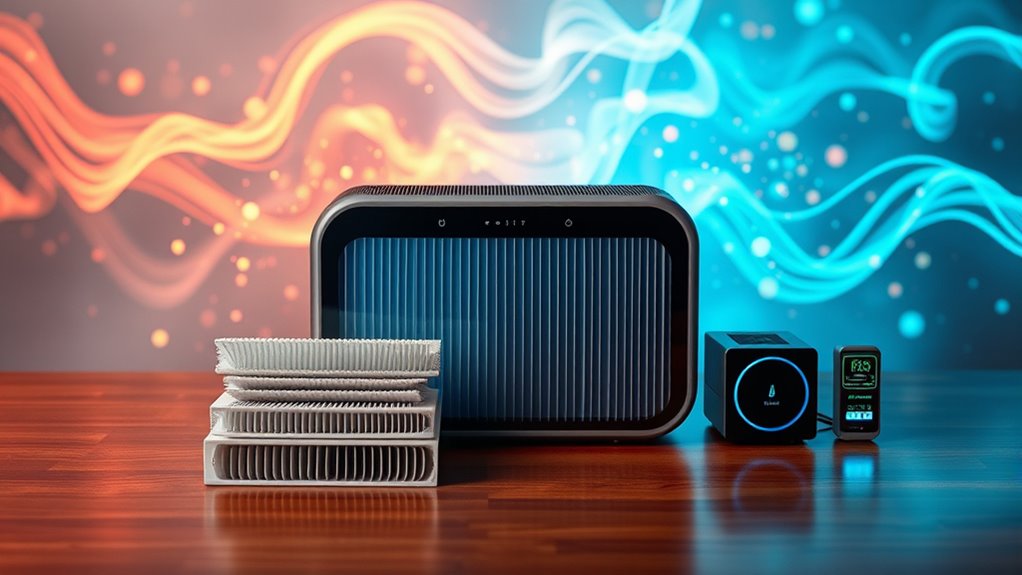
Modern air filtration technology is transforming how you breathe indoors.
With innovative filtration methods, smart air monitoring systems, and a focus on sustainable materials, air purifiers are becoming more efficient and environmentally friendly.
You’re not just improving air quality; you’re also engaging with cutting-edge technology that enhances your living space.
Innovative Filtration Technologies
Air purification has come a long way, thanks to innovative filtration technologies that enhance indoor air quality. Modern systems utilize HEPA filters, capturing at least 99.97% of airborne particles. Activated carbon filters further improve safety by neutralizing VOCs and odors. Innovative designs, like 360-degree air intake, amplify the efficiency of air purification across larger areas.
Here’s a summary of key filtration technologies:
| Filtration Technology | Benefits |
|---|---|
| HEPA Filters | Removes 99.97% of particles (0.3 microns) |
| Activated Carbon | Neutralizes VOCs and odors |
| 360-Degree Intake | Enhances air circulation and efficiency |
| Smart Technology | Monitors air quality in real-time |
These advancements in filtration systems are essential for achieving advanced air quality in your space.
Smart Air Monitoring
Anyone looking to improve indoor air quality will appreciate the benefits of smart air monitoring technology. This innovation uses smart technology to provide real-time data on air quality, allowing you to effectively track pollutants and allergens.
Here are some key features:
- Advanced filtration systems automatically adjust settings based on detected air quality changes, enhancing efficiency.
- Many air purifiers come with mobile apps that let you monitor air quality remotely and receive alerts.
- Artificial intelligence integration predicts air quality trends, optimizing performance based on historical data.
- Emphasizing environmental responsibility, these devices utilize sustainable materials while delivering effective air cleaning solutions.
With smart air monitoring, you can take proactive steps toward a healthier indoor environment.
Sustainable Material Development
As you explore advancements in air purification, you’ll find that sustainable material development is at the forefront of creating effective and eco-friendly solutions.
Companies are turning to sustainable materials, including biodegradable filters and recycled resources, to minimize environmental impact. Research in nanotechnology has led to filtration media that efficiently captures pollutants, reducing the need for synthetic fibers.
Innovations like photocatalytic oxidation utilize eco-friendly catalysts to degrade airborne contaminants without harmful byproducts. Additionally, the integration of smart technology enables real-time monitoring of air quality, encouraging efficient energy use.
This approach not only improves air quality but also promotes a circular economy, ensuring that the air purification industry aligns with sustainability goals while enhancing overall performance.
Environmental Responsibility
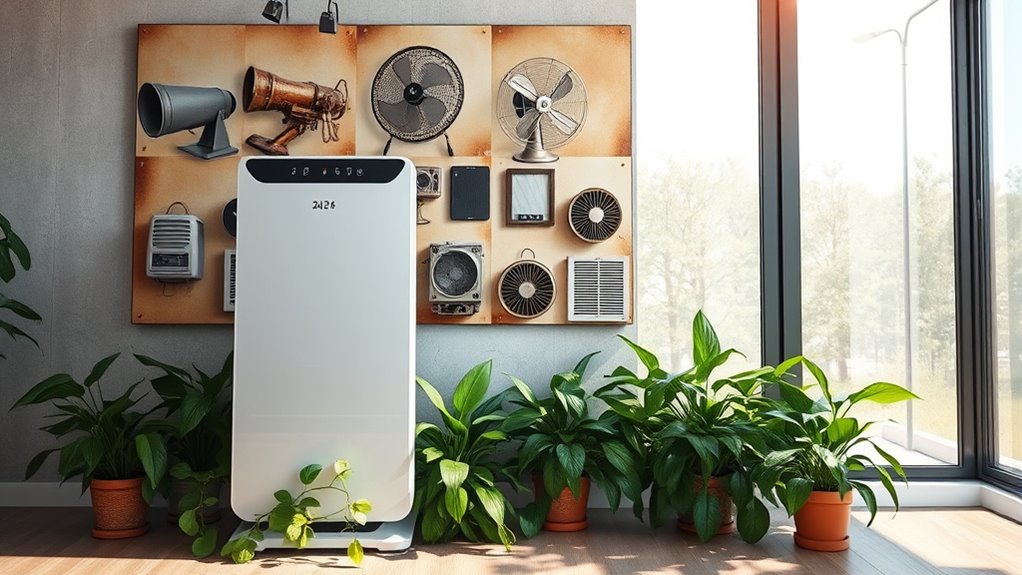
Recognizing the importance of clean air, industries are increasingly adopting air purification technologies that reflect a commitment to environmental responsibility.
This evolution emphasizes several key aspects:
- The Clean Air Act set national air quality standards, driving advancements in air filtration technology.
- HEPA filters play an essential role in reducing airborne pollutants, greatly improving indoor air quality.
- Eco-conscious manufacturing practices, especially in sectors like laser cutting, promote greener operations.
- Ongoing research into sustainable materials aims to enhance ecological health while maintaining effective air filtration.
The Future of Air Purification
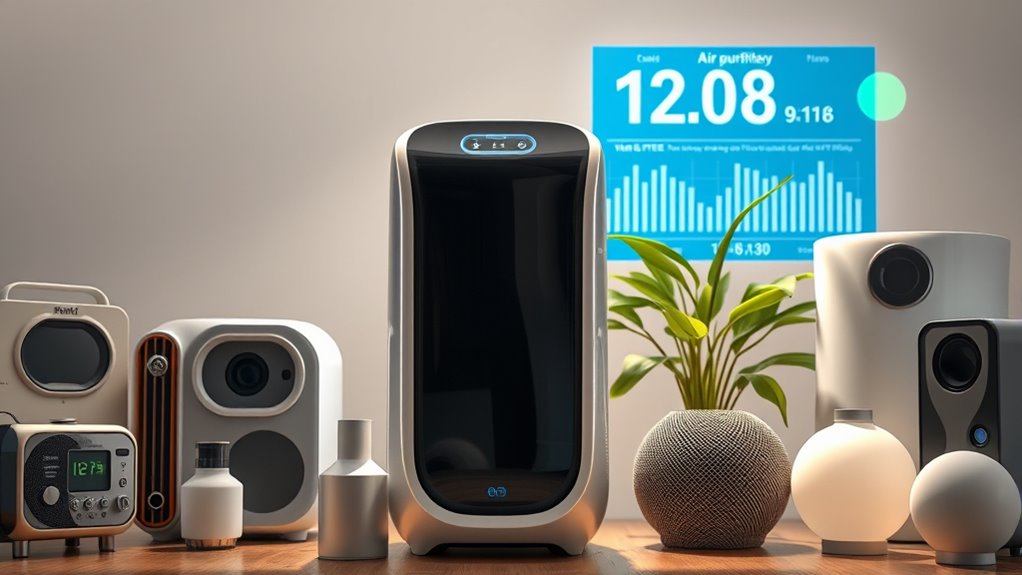
With the rising awareness of air quality issues, the future of air purification technology looks promising and dynamic.
You’ll witness a surge in demand for advanced filtration systems, driven by increasing airborne diseases and air pollution. HEPA filters will continue to dominate the market, ensuring effective removal of microscopic allergens.
Future air purifiers will tackle complex pollutants, including toxic gases, greatly improving indoor air quality. Innovations in smart technology will allow for real-time air quality monitoring, empowering you to make informed decisions about your environment.
As research progresses, expect sustainable materials to enhance the efficiency and effectiveness of these filtration systems, making your spaces healthier and more comfortable than ever before.
Embrace the future of air purification—it’s evolving for the better!
Frequently Asked Questions
What Is the History of Air Purification?
Air purification has a rich history that dates back centuries. You’ll find that early ideas, like cloth respirators proposed by da Vinci, laid the groundwork for modern systems.
By the 19th century, inventions like charcoal filters for miners emerged due to rising pollution. During World War II, HEPA filters were created to capture tiny particles.
Eventually, the commercialization of air purifiers in the 1960s helped bring cleaner air into homes, greatly impacting public health.
What Is Air Purifying Technology?
Imagine you’re in a cozy living room, breathing in fresh air thanks to an air purifier.
Air purifying technology involves devices that remove harmful pollutants and allergens from your indoor environment. For instance, HEPA filters trap tiny particles, ensuring you breathe cleaner air.
Alongside these, activated carbon filters tackle unpleasant odors. By using such technology, you can greatly enhance your home’s air quality and promote better health for you and your loved ones.
What Is the Technology Behind Air Purifiers?
Air purifiers use advanced filtration technologies to clean the air you breathe. They often feature HEPA filters, which capture 99.97% of particles, including allergens and dust.
Many models also include activated carbon filters that absorb odors and harmful gases. Some even utilize ionization technology to clump airborne particles together for easier removal.
With modern designs, you can find smart air purifiers that automatically adjust based on real-time air quality, enhancing your environment.
Did NASA Invent Air Purifiers?
No, NASA didn’t invent air purifiers. However, they markedly advanced air filtration technologies for spacecraft, ensuring astronauts breathed clean air.
Their research in the 1970s led to portable air purification systems that effectively removed harmful pollutants.
While NASA’s innovations were vital, they built on existing technologies like HEPA filters.
Conclusion
As you breathe in the fresh air around you, remember that air purification technology has evolved from ancient methods to cutting-edge solutions. Just like a tree filters out pollutants while providing life-giving oxygen, today’s advanced filters work tirelessly to keep your indoor environment clean and healthy. With increasing awareness of air quality’s importance, you’re not just investing in technology; you’re nurturing a healthier future for yourself and generations to come. Breathe easy—you’ve got the power!
